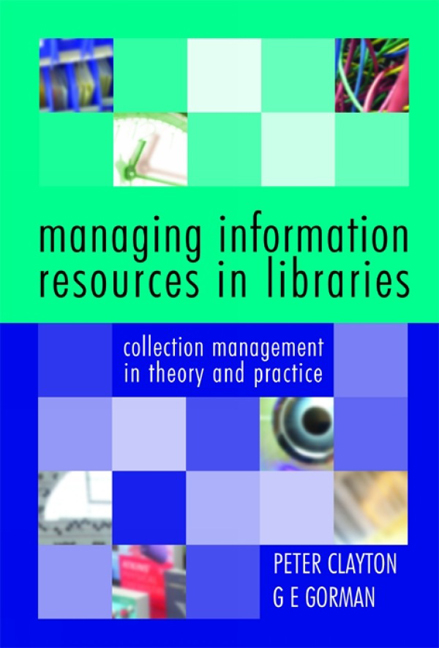Book contents
- Frontmatter
- Contents
- About the authors
- Preface
- 1 Managing information resources in context
- 2 Collection management and collection development policies
- 3 Conspectus
- 4 Resource sharing and co-operative collection development
- 5 Selection: policies and procedures
- 6 Selection resources
- 7 Acquisitions processes and procedures
- 8 Budget management
- 9 Collection evaluation and review
- 10 Preservation and weeding
- The literature of collection management Adela Clayton
- Index
3 - Conspectus
Published online by Cambridge University Press: 08 June 2018
- Frontmatter
- Contents
- About the authors
- Preface
- 1 Managing information resources in context
- 2 Collection management and collection development policies
- 3 Conspectus
- 4 Resource sharing and co-operative collection development
- 5 Selection: policies and procedures
- 6 Selection resources
- 7 Acquisitions processes and procedures
- 8 Budget management
- 9 Collection evaluation and review
- 10 Preservation and weeding
- The literature of collection management Adela Clayton
- Index
Summary
Focus questions
• What is Conspectus?
• What is the role of Conspectus in a collection development policy?
• How might traditional approaches to Conspectus be updated to reflect the need to deal with electronic as well as print information sources?
Clearly, a collection development policy will be of little value if it does not say what a library has or intends to acquire or provide access to in any particular subject area. The Research Libraries Group (RLG) Conspectus approach has often been recommended to describe the collecting levels for various subject areas in a collection development policy. In fact it is the only widely acknowledged means of doing this. Despite its origins in research libraries, Conspectus is a tool relevant to many kinds of library. Accordingly, we need to describe Conspectus and give some indication of its strengths and weaknesses. Because the development of Conspectus predated the widespread availability of electronic information, in our view it needs to be updated to reflect this if it is to be of continuing relevance to the library community.
What is Conspectus?
Conspectus is
… a system which enables information about the collections of libraries and their collection development practices to be recorded in a relatively standardised way and which allows some detailed comparisons to be made between the collections of libraries involved. The term is used to refer both to the methodology involved in describing collections and to the database of standard collection descriptions that results.
It was developed by the RLG in the USA to describe collection strengths and collection development intentions in a uniform manner. Analysis is based on a library classification scheme, and strengths and collecting intentions are assessed against a set of more-or-less universally agreed categories ranging from 0 (out of scope – the library does not collect in this area) to 5 (comprehensive – the library attempts to collect exhaustively); see Figure 3.1.
RLG collection level codes are used by collection managers to indicate their subjective assessment of:
• how a collection has been created in the past (Existing Collection Strengths, ECS)
• the current focus within the collection (Current Collection Intensity, CCI)
• how they intend to approach the collection in the future (Desired Collection Intensity, DCI).
- Type
- Chapter
- Information
- Managing Information Resources in LibrariesCollection Management in Theory and Practice, pp. 37 - 51Publisher: FacetPrint publication year: 2006



